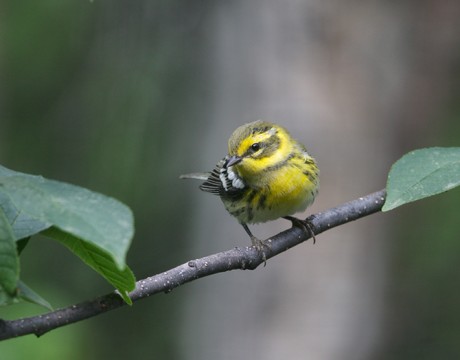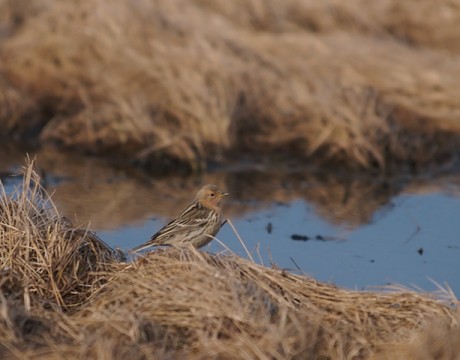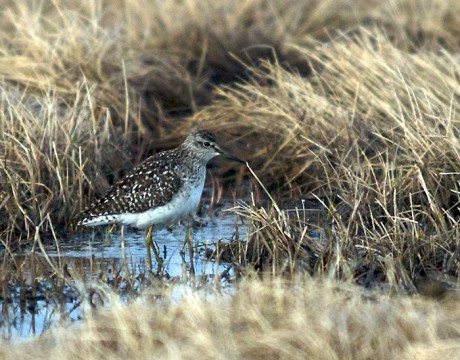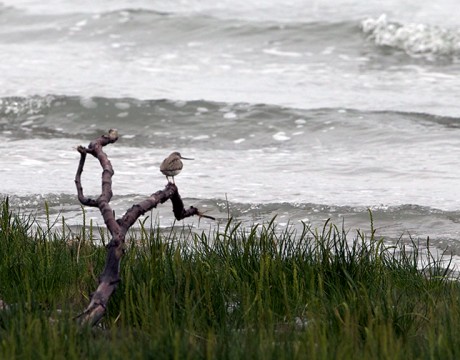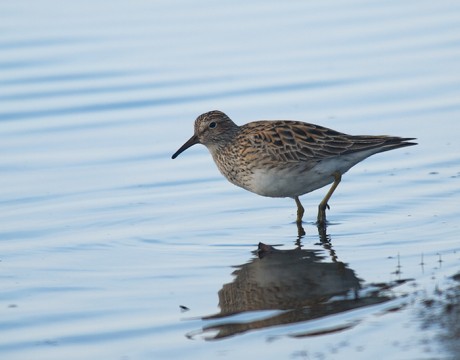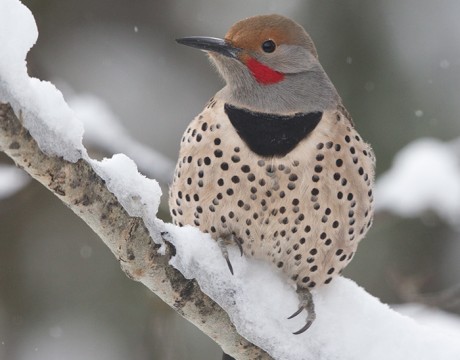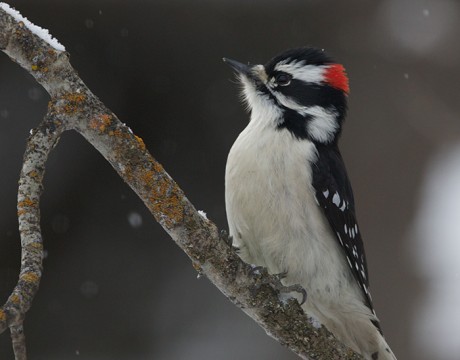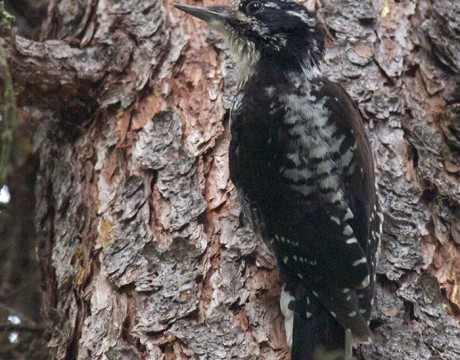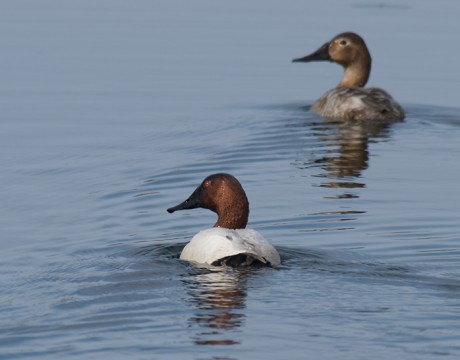The Last Bird of the Week – Townsend’s Warbler
This is the last of Wickersham’s Conscience’s Birds of the Week. We’ve run through the last species WC photographed in Alaska. The total is 187, if anyone is curious. And for this last species, WC has saved the beautiful Townsend’s Warbler, Alaska’s prettiest warbler. That colorful, strongly marked face makes it easy to identify in the field. While this is a female, and less strongly marked, you can still see what a handsome warbler this is. You can see how much vivid the male’s coloration is in this photo from Anchorage. A beautiful bird, and a good place to wrap…
Bird of the Week – Red-throated Pipit
A last Asian vagrant, a cousin to the American Pipit, this is a Red-throated Pipit. As you can see, it isn’t just the throat that is red but the whole head. This is another “Uncommon” Asian vagrant. Birders get slightly more excited about this one, possibly because it isn’t just another sandpiper. By the way, the bird was incredibly hard to see as it moved among the dead early spring grasses. For more bird photos, please visit Frozen Feather Images.
Bird of the Week – Wood Sandpiper
Yes, yet another sandpiper, but this one is the last and, besides, it’s another Asian vagrant. We found this bird in the swamp near the Far Boneyard on Gambell, St. Lawrence Island. It’s found a bit more often than last week’s Terek Sandpiper, so its status is “Uncommon,” as opposed to “Casual,” meaning that it is seen pretty much every year, usually out in the Aleutian Islands. The greenish-yellow legs, whitish eyebrow and short, dark bill make this fairly easy to identify in the field. Among serious birders, seeing a Wood Sandpiper is no big deal; it was a lifer…
Bird of the Week – Terek’s Sandpiper
WC’s Bird of the Week feature is reaching the end of WC’s photo list of Alaska birds. Three of the next four birds are Eurasian species that WC was lucky enough to photograph. The first is a Terek’s Sandpiper, which appeared in Anchorage a couple of years ago. Note the distinctive long, up-turned bill on this species. You can’t see if clearly in this photo but the legs are yellow-orange. Terek’s are a Eurasian species, “casual” in Alaska, a birding term that means you see them once in a blue moon. As you might imagine, there were hordes of birders of…
Bird of the Week – Baird’s Sandpiper
WC overlooked a sandpiper species when working through the long list of sandpipers that breed in Alaska: Baird’s Sandpiper. Baird’s move through the southern two-thirds of the state en route to their high arctic breeding range. Like the Pectoral Sandpiper, the darker feathers end half way down the chest, but tend to fade out, rather than a sharp transition. But you can tell them apart by the black legs, in contrast to the yellow legs of a Pectoral. One of the most remarkable characteristics of Baird’s is that it makes one of the largest metabolic investments in egg production known in…
Bird of the Week – Northern Flicker
The Northern Flicker is Alaska’s most colorful woodpecker. If the others are variations on black and white, with maybe a touch of color, the Northern Flicker broke the mold. This photo isn’t from Alaska; it’s from Central Idaho, but WC includes it because it captures the remarkable color and patterns of this extravagant bird. Here’s a photo from Alaska. Unlike the other woodpeckers posted, this one is primarly a ground-forager, a woodpecker that doesn’t peck wood. Although it does drum to establish territories and does forage on trees from time to time. The taxonomy of Flickers is . . ….
Bird of the Week – Downy Woodpecker
Continuing with woodpeckers, this is Alaska’s smallest woodpecker, and probably the most common year round. In many ways, the Downy is a smaller version of the Hairy, with similar patterning. But the Downy is much smaller, and has a proportionately smaller bill. The male has the red barring on the back of his head shown here. The female does not. Interior Alaska, where these birds were photographed, is near the northerly limits for this species, but the range of Downys is huge. In fact, they are found in all 49 continental states and all of the Canadian provinces. Like Hairy…
Around the Lens Podcast: Trump’s Photographer
Panelists: Brian Munoz (http://brianmmunoz.com/), Trent Stevens (http://www.trentcamera.com/) News: Best photos from Inauguration Day (http://www.politico.com/gallery/2017/01/2017-trump-inauguration-day-photos-002396?slide=0) What were the best photos from inauguration day. We give our thoughts. Topic: Will Trump have a Photographer (http://time.com/4637153/trump-inaugur…) Time reports that Trump has not yet hired a photographer. Will Trump end 40 years of precedent and not have one? Gear: Fuji Announces GFX 50s (https://petapixel.com/2017/01/19/fuji…) Fuji is getting set to release a medium format camera that fits in a DSLR sized body. Does this camera intrigue us?
Bird of the Week – American Three-toed Woodpecker
We’ll go back to woodpeckers for a while. The American Three-toed Woodpecker is a medium-sized black-and-white woodpecker. The male has a small yellow patch on his forehead. The feet do indeed have only three toes, instead of the more common four: 2 forward and 1 backward. (The Black-backed Woodpecker has the same configuration.) The Three-toed can be a difficult bird to find. Unlike other woodpeckers, it doesn’t drill. Instead, it flakes off pieces of spruce bark to get to insects. It prefers spruce bark beetles, but is otherwise a generalist. Three-toeds will drum to establish territory, often picking a dead…
Bird of the Week – Canvasback
Back when WC was working through waterfowl earlier in this series, he overlooked an uncommon but widely distributed duck, the Canvasback. The bird is hard to overlook; the drake’s red eye and canvas-white back are very distinctive. It’s also the largest of the diving ducks. The very long bill is equally distinctive; only the Northern Shoveler has a bigger bill. The Canvasback is closely related to and can hybridize with the somewhat similar Redhead. Which also occurs in Alaska but, alas, WC doesn’t have an Alaska photo of the species. For more bird photos, please visit Frozen Feather Images.





